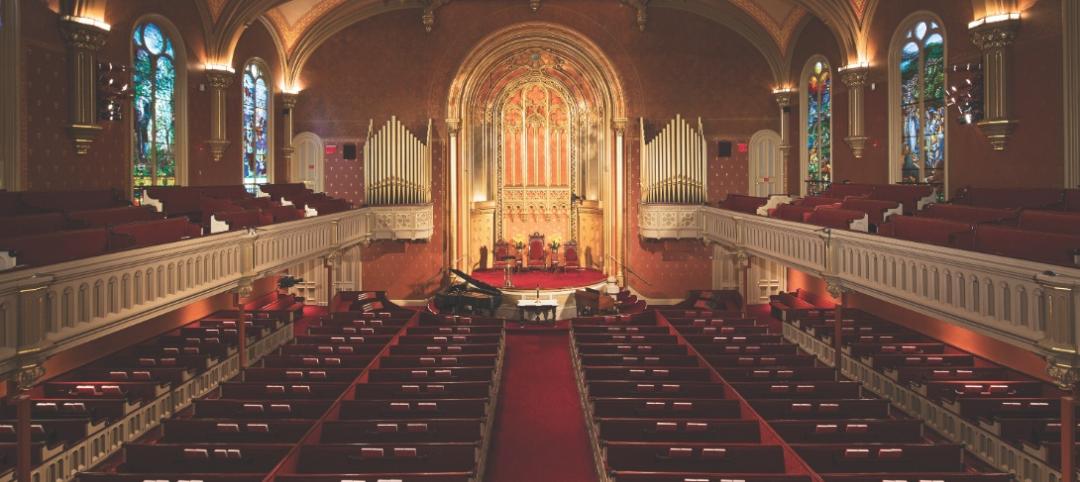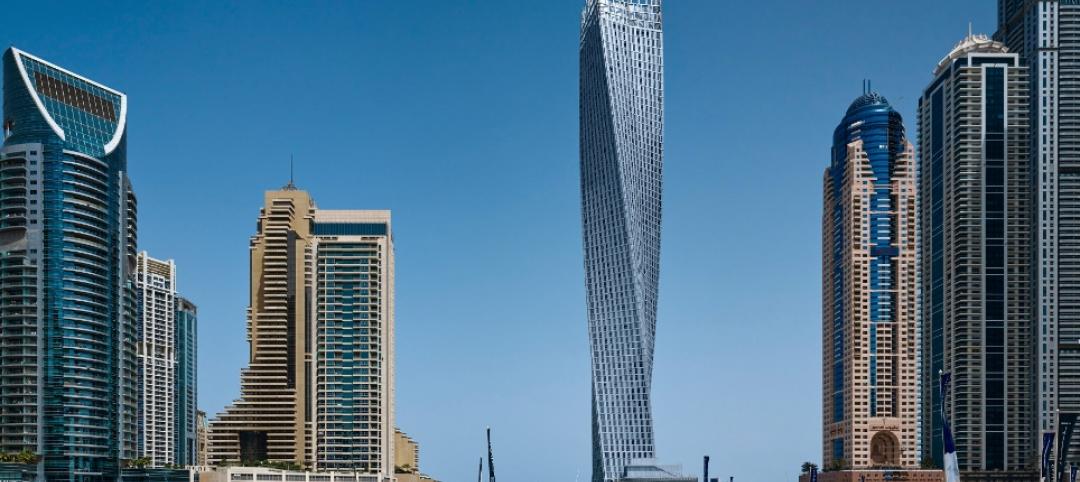There’s more to creating a sustainable hotel than saving water and power by asking guests to reuse their towels. Nevertheless, O&M—from laundry reduction to soap conservation to waste recycling—has long been the major green focus of the hospitality industry, eclipsing sustainable capital projects. Though most lodging chains have adopted sustainability targets, fewer than 100 hotels in the U.S. have achieved LEED Gold or higher to date, including just three Platinums.
A long-awaited version of LEED for Hospitality, which would reflect the unique characteristics of the building type, might encourage more owners and developers to consider certification. But the plan was sidelined as USGBC worked on LEED v4, with hotel-oriented tweaks still contemplated under the NC, EB, and CI systems. Some firms aren’t waiting, and have announced intentions to make their future capital developments greener.
The LEED Volume program, launched in late 2010, aims to grease the wheels by granting precertification of properties once an initial prototype is certified. Marriott was an early adopter, successfully enrolling its Courtyard, TownePlace Suites, and Residence Inn brands. The firm is still working on others, with a stated goal of achieving 300 LEED properties by 2015. Thirteen have hit the mark so far, including seven Golds. Other hospitality-sector Volume participants include Starwood Hotels & Resorts (for the Element brand) and IHG (LEED-EB, for its Green Engage program).
Once the home of Fox Jewelry, this 19th-century building in Grand Rapids, Mich., has been reborn as the boutique, 28-room CityFlats Hotel. Like its new-construction sister property in Holland, Mich., the five-story CityFlats has been certified LEED Gold. Sustainable features include cork flooring, high-efficiency heating and cooling units with occupancy sensors, low-flow plumbing, energy-efficient lighting, and countertops made of Cradle to Cradle–certified glass and concrete. The Building Team: Charter House Innovations (developer), GMB Architecture + Engineering (architect), and GDK Construction (contractor). MICHAEL BUCK / M-BUCK STUDIO
Green marketing to consumers is also gathering steam in the sector. A 2008 survey by Deloitte (http://bit.ly/17389dQ) indicated that business travelers are increasingly interested in sustainable lodging. Forty percent of respondents said they’d be willing to pay a premium for it.
Hotel search engine TripAdvisor (www.tripadvisor.com) quietly rolled out its GreenLeaders program earlier this year, in cooperation with Energy Star, the USGBC, and the United Nations Environment Programme. TripAdvisor vets applicant properties for green O&M but also looks at building design aspects, such as glazing, lighting, HVAC, and landscaping. “Badge” rankings—Bronze, Silver, Gold, and Platinum—are promoted on the TripAdvisor site. Consumers can now select “green” as a search filter, putting sustainability on a par with characteristics like “romantic” and “luxury.” The program is free to participating hotels, which must agree to submit to a third-party audit if questions arise, including consumer feedback regarding inaccurate sustainability claims.
Though they’re less well known to the general public, alternative paths to green hotel branding exist. The main players are Green Key Global (encompassing about 3,000 hotels in the U.S. and Canada); Green Seal, which currently has about 80 participants certified under its GS-33 Standard for Lodging Properties; and Audubon International, with about 150 Green Lodging Program properties concentrated in New York and Florida. Annual participation costs range from $400 to $3,000 per property, involving assessments of O&M as well as the built environment. Some programs require verification by an independent auditor. None are as structure-oriented as LEED.
Alabama’s first LEED Silver hotel, the new 10-story Westin Birmingham, is part of Starwood’s 30/20/20 initiative. The program urges all the company’s properties to reduce energy consumption by 30% and water consumption by 20% by the year 2020. LEED credits related to Sustainable Sites and Indoor Environmental Quality were a focus for the Birmingham project. B&G-MCS A Joint Venture, combining Brasfield & Gorrie and Monumental Contracting Services, created the building in cooperation with Rabun Rasche Rector Reese Architects. Also on the Building Team: The Safaie Landry Partnership (MEP/FP), MBA Structural Engineers (SE/CE), and Bhate Engineering Corp. (geotechnical). © MASON FISCHER PHOTOGRAPHY / COURTESY BRASFIELD & GORRIE
Starwood’s “eco-wise” Element brand, launched in 2008, is another powerful illustration of how seriously the sector is now taking green marketing. The first international property, Element Vaughan Southwest, opened in suburban Toronto this past September, joining 10 U.S. properties. Starwood hopes to roll out more Elements in Europe, North America, and Asia during the coming decade. LEED, minimally at the certified level, will be pursued brand-wide; the flagship Lexington, Mass., property was Starwood’s first Gold-level project. Element’s marketing language combines the traditional “reuse-reuse-recycle” theme with LEED education.
With the AIA Consensus Construction forecast predicting 15% growth in the hospitality sector next year, on top of this year’s 17% increase, investments in green projects may finally be making more sense to decision makers. There’s plenty of room for progress in both the new construction and renovation categories, building on the operational green thinking that’s already pervasive. Stephen Galbreath, AIA, ISHC, LEED AP BD+C, says adaptive reuse of historic properties, an inherently sustainable choice, looks particularly exciting right now.
“Several brands, such as Virgin Hotels and Trump Hotel Collection, have already started to embark on this trend,” says Galbreath, VP for the Commercial Practice Group at RTKL, an ARCADIS company. “Reportedly, Virgin is set to transform an existing Chicago office building, and Trump Hotel Collection is reinventing the Old Post Office building in Washington, D.C. The possibilities of reimagining historic buildings that were never before considered as candidates for hotel development are overwhelming. These are now thought of as viable and sustainable options for hospitality environments.”
The Conrad New York, created through expansion and renovation of an existing Embassy Suites hotel, achieved LEED Gold this year. The 463-suite luxury property also has earned an ISO 14001 certification in environmental management. A green roof and garden provides vegetables for two restaurants, and LEDs account for more than 60% of the hotel lighting. Water-conserving fixtures and sustainable materials contributed to the Gold rating. The Building Team: Kohn Pedersen Fox Associates, Kuwabara Payne McKenna Blumberg, Monica Ponce de Leon Studio, and Deborah Berke Partners (architects), Jill Greaves Design and Remedios Studio (interiors), L’Observatoire International (lighting design), WSP Flack & Kurtz (MEP), Thornton Tomasetti (SE), and F.J. Sciame Construction and Hunter Roberts Construction Group (contractors). MICHAEL MORAN
Related Stories
| Oct 28, 2013
Packard Foundation’s headquarters receives ILFI Net Zero certification
The Packard Foundation’s 49,000-sf headquarters recently achieved Net Zero Energy Certification through the International Living Future Institute (ILFI), making it the largest such building in the world.
| Oct 28, 2013
Metal roofs are topping more urban dwellings
Given their durability and ease of use, metal roofs have been a common feature on rural houses for decades. Now they’re becoming an increasingly popular choice on urban dwellings as well.
| Oct 25, 2013
Hoffmann Architects announces launch of U.S. Capitol Dome restoration
The Architect of the Capitol will undertake comprehensive restoration of the 150-year-old cast iron Dome, which has not undergone a complete restoration since 1959-1960.
| Oct 23, 2013
AIA: Crowd-funding shows promise for financing real estate projects
The American Institute of Architects issued a statement on the SEC's recent 5-0 vote to propose rules aimed at letting startups tap large numbers of ordinary investors for small amounts of capital.
| Oct 23, 2013
Manhattan's landmark Marble Collegiate Church modernized
Helpern Architects, Structure Tone led the Building Team in a multi-phase project.
| Oct 23, 2013
Gehry, Foster join Battersea Power Station redevelopment
Norman Foster and Frank Gehry have been selected to design a retail section within the £8 billion redevelopment of Battersea Power Station in London.
| Oct 23, 2013
Some lesser-known benefits of metal buildings
While the durability of metal as a construction material is widely recognized, some of its other advantages are less commonly acknowledged and appreciated.
| Oct 23, 2013
Architecture Billings Index hits seven-month high in September
AIA's Architecture Billings Index was 54.3 in September, the highest level since February 2013
| Oct 22, 2013
World's tallest twisting tower added to Dubai skyline [slideshow]
The 75-story residential building, designed by SOM, features a dramatically rising helix shape for a distinctive addition to the city’s skyline.
| Oct 22, 2013
Still a long way to go toward improving worker safety
Last year, there were 775 fatalities among U.S. construction workers: 133 among those in the construction of buildings, 169 in heavy/civil engineering projects, and 456 involving workers in specialty trades. What can construction firms do to prevent fatalities? Building a culture of safety must start at the top.




















